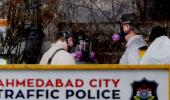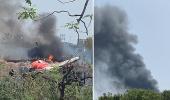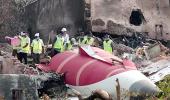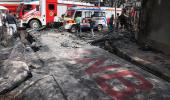'If major components of any dead body from which you can retrieve DNA is available, that is enough.'
"The more the fragmentation of the body, the lesser the chance of identification," Dr Rajesh Chandrakant Dere tells Vaihayasi Pande Daniel/Rediff.

How long does this initial process of sorting the remains of the bodies take? It must be slow?
We do not need 100 per cent of the body for it to be configured. It is impossible in an accident like that (to find all parts of a body). We want majority of only certain fragments -- if we get 2-3 leg bones and a trunk, which we match morphologically that is enough for us.
To create a DNA profile for a body, we need the long bones, hip bone, sternum, humerus, molar teeth, root of the teeth, dental enamel with root. If this many parts are available, we can do a full DNA profile.
No need to search for 100 per cent of the body. It would be an impossible task. If major components of any dead body from which you can retrieve DNA is available, that is enough.

The crash site would, of course, be cordoned off and they will be collecting all these parts. Will they be sending these parts immediately to a medical college nearby or out of Ahmedabad for testing?
They have two medical colleges right there. They also have a Regional Forensic Science Laboratory in Ahmedabad.
If the sample study number is large (too many to handle), they can send it to nearby states too -- Maharashtra, Hyderabad -- to distribute the work.
DNA sample sending is easy; you have flights on which you can send bone and teeth enamel samples easily.

How long does this whole process of identifying the DNA of the fragments take?
It's simply a PCR test. It will take a minimum of 8 to 12 hours to complete for each fragment. But in a machine, you can put multiple samples. And if the sample number is more, they can send it to neighbouring states too.
It's a bit like putting together a 1,000-piece puzzle? In the case of the September 11, 2001 attacks in the US, identifying the victims' remains took many years. How long will this take?
I have done more than 100 post mortems of Taj Palace victims of Mumbai's 26/11 terror attack. I was part of the team that was coordinating with Israel for this and got appreciation for this task. We did it within three weeks or a month.
But that tragic incident was different. That was a shootout. There was not much mutilation of the bodies. It was gunshot injuries. The bodies were easy to identify because the facial configuration was preserved. It was not a bomb blast or a fire, it was a firing case.
Identification in this case will take longer?
Yes. Identification is more difficult. The more the fragmentation of the body, the lesser the chance of identification.
Will it take a couple of months?
No, no, I don't feel so. I think around a month. In one month, they should be able to do it on priority.
- NEXT: When DNA Falls Short...
Feature Presentation: Ashish Narsale/Rediff










